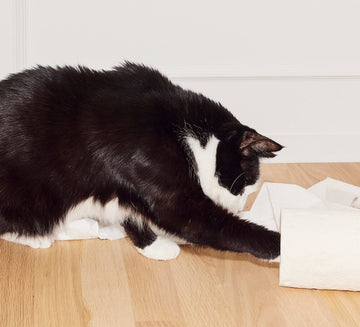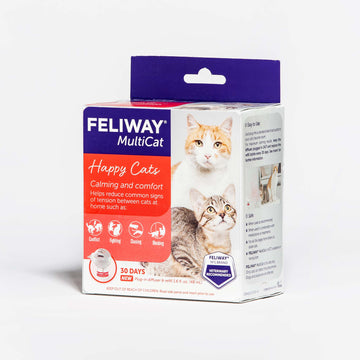Curb your cat's behavior issues with online vet help
Talk to a vet online today about how to fix behaviors like scratching and peeing indoors. Plans start at $11/mo.

- Unlimited vet visits and follow-ups
- Prescriptions delivered free to you
- 100% licensed veterinarians

What to know about destructive behavior in cats
Learn what causes destructive behavior in kitties and what to do about it.


Boredom or lack of enrichment
Boredom or lack of enrichment
If your cat or kitten isn’t getting enough stimulation or opportunities to release their energy, they might take it out by scratching furniture, knocking things down, destroying plants, and other destructive behaviors. They may also act aggressively toward humans or other pets. Having plenty of toys, scratching surfaces, and a cat tree to climb can help prevent your feline friend from misbehaving.
Stress or anxiety
Stress or anxiety
Cats that are anxious or stressed may end up causing destruction around the house, damaging your furniture and belongings. They may also pee in inappropriate places or meow excessively.
Pica
Pica
If your cat is eating non-food objects around the house, such as fabrics, paper, and toys, they may be experiencing pica. Pica is a medical condition that causes cats to crave and ingest non-food items. It can eventually lead to serious medical issues (especially if your cat has stopped eating their cat food) so if you see your cat eating something weird or suspect pica, talk to a vet.
Pain or illness
Pain or illness
If your cat bites at your furniture or other objects around the house, they may be experiencing pain in their mouth or teeth. Certain illnesses may also cause your cat to go to the bathroom outside the litter box or meow excessively. And pica may be a symptom of a nutritional deficiency.
Medicine & treatments for destructive behavior
Medicine & treatments for destructive behavior
Is your cat acting up? Dutch’s team of licensed vets is here to help figure out the root cause of the behavior and how to fix it. Talk to one of our vets over video and they’ll develop a custom treatment plan that may include prescription medications, over-the-counter treatments, behavior modifications, and enrichment advice.
How Dutch works
-
Pick a plan and become a member
-
Schedule a video call with a licensed vet
-
Order the prescriptions the vet recommends
Frequently asked questions
What can I use Dutch for?
What can I use Dutch for?
With Dutch, you’re never alone when it comes to your pet’s health. Whether your pet needs care or you just have a question, our compassionate and knowledgeable vets are always happy to help.
Here are some ways you can use Dutch:
- Care & prescriptions for over 150 issues
- Behavioral health, nutrition, and exercise advice
- Puppy, kitten, and new pet parent advice
- Preventive care plans
- Night and weekend vet care
- Second opinions & follow-up care after in-person visits
- Advice on whether you need to go to the ER or urgent care
- Vet care when you’re traveling
- Easy prescription refills
- Longevity treatment plans
- Answers to non-urgent questions
What is a visit with Dutch like?
What is a visit with Dutch like?
When booking a video call with a vet, you'll be asked a few questions about your pet’s health issue. Depending on the issue, you may also be asked to fill out a longer questionnaire about their symptoms and share photographs of them so our veterinarians can better understand what’s going on. You’ll then pick an appointment time that works best for you.
During your video call, one of our licensed veterinarians will talk to you about the symptoms your pet is experiencing, ask you questions, review your pet’s medical history if you’ve provided it, and answer any questions you have. The vet will ask to see your pet and their environment. And they may ask you to perform some simple checks on them if needed.
After your video call, the vet will send you a message with a custom treatment plan to help your pet feel better, including a link to buy any recommended prescription or over-the-counter medications. Place your order and we’ll ship it free.
How do I know if you can treat my pet?
How do I know if you can treat my pet?
Our vets can provide care and prescriptions for more than 150 issues — and over 90% of cases can be treated virtually.
The vet can diagnose your pet based on your description of their symptoms, their medical history, seeing them during your video call, and, if needed, through uploaded photos and videos. They may ask you to do a few simple checks during the call. We also offer a number of at-home lab test kits for dogs and cats.
The health and safety of pets is our top priority. In the rare case that a vet determines a pet needs to go to a local clinic, they’ll provide a referral and offer advice on how to care for them until they can be seen.
Some things that require in-person care include emergencies, wounds that need stitches, and issues that require blood work, imaging (X-rays or ultrasounds), or surgery.
Our vets are always available for second opinions and follow-up care after in-person vet visits — so you don’t have to navigate health issues alone.
How much will it cost for Dutch to treat my pet?
How much will it cost for Dutch to treat my pet?
Our memberships are designed to make your pet’s care as easy and affordable as possible. Here’s how your costs will break down:
Membership: You can choose to pay the total price upfront or in 4 installments. All memberships include unlimited care for up to 5 pets at no extra cost.
Vet calls and messaging: No cost — video chat and message with vets as often as you need for free.
Medication: The price will vary depending on your pet’s needs. To keep your costs down, we offer a price-match guarantee, free standard shipping, $25 off your first product order, and 20% off your first flea & tick order.




